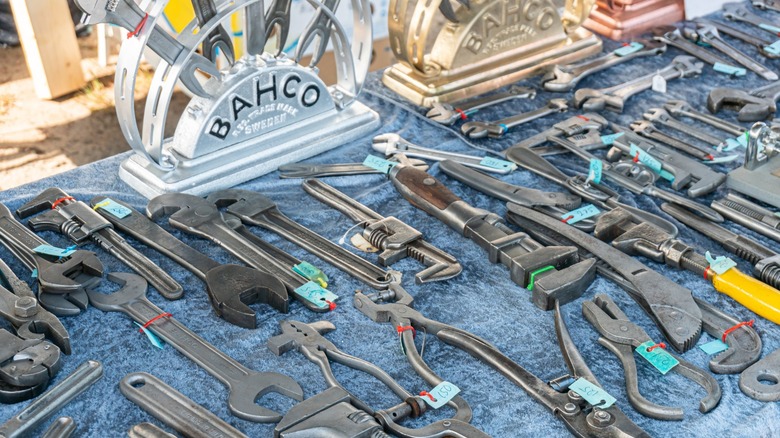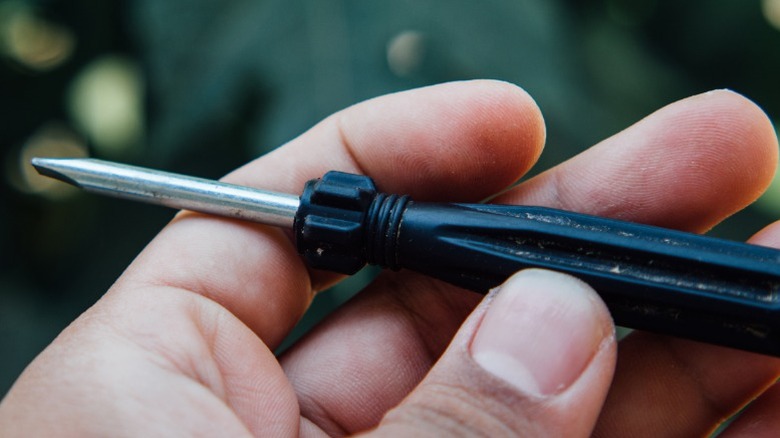How To Inspect A Used Tool Before Buying It
If you work in the trades or are an enthusiastic DIYer, you most likely understand the value of owning a large and varied collection of tools. Tools are necessary for virtually every professional trade, like auto repair, construction, plumbing, and electrical work, as well as for innumerable hobbies and DIY tasks. However, tools, especially high-quality ones, can often be prohibitively expensive. If you're a casual DIYer or an entry-level tradesperson, building your collection can be a costly and protracted experience.
Fortunately, there are various ways to build a professional tool kit on a budget, including shopping for used tools. Buying second-hand tools can be a great way to save some cash, especially when it comes to things like hand tools and other devices that can last for decades of use. It's often easy to find used tools with prices far cheaper than new versions, and there are many different ways to build a solid kit with second-hand devices. Some of the places you can look for used tools include pawn shops, garage and estate sales, classified ads, as well as online sites like Facebook Marketplace, eBay, and Craigslist.
However, while buying used tools can be a wonderful way to build your collection on a budget, used tools also come with risks, and there are a few types of tools that aren't worth buying used. Used tools may be broken or damaged, or the seller may be dishonest about the device's brand or quality. Because of this, it's important to inspect used tools thoroughly before buying. If you're wondering how to perform a used tool inspection, we've got you covered.
Inspect the tool for physical damage or signs of misuse
The first thing you need to do when inspecting a used tool is look for obvious signs of damage or misuse. That may translate to missing parts, torn up grips on handles, bent components, or anything obviously broken or marred in a way that inhibits the tool's use. For example, when examining a used screwdriver, check for signs that it's been used incorrectly, like a bent shaft that could indicate it was used as a pry bar, or a damaged tip that may prevent it from working properly to remove and install fasteners. When inspecting power tools, look for frayed or damaged cables if the tool is corded, as well as signs of damage to the body or casing, including things like chemical residue or burn marks.
In addition to obvious physical damage, you should also check for less obvious signs of damage or misuse. Say you're considering buying a used torque wrench, look for signs of minor damage around the ratcheting head. While light damage and scratches may indicate nothing other than normal use, they could also mean that the tool was used incorrectly, potentially damaging the internal gears. The same applies to other tools with delicate internal components, like power tools and other ratcheting devices.
Finally, it's worth noting that physical damage isn't always an immediate red flag. You should expect used tools to have some physical blemishes, but it's important to be able to tell the difference between gross misuse and normal wear and tear. It's also critical to compare the seller's asking price to the damage when determining whether a used tool is a bargain or something that you should pass.
If possible, test any used tools before buying
As mentioned, it's important to look for less obvious signs of damage when buying used tools. Part of that step involves testing the tool to see if it works properly. If you're buying used tools online, you most likely won't be able to perform a comprehensive inspection. However, you should ask for detailed videos of the device in use.
When inspecting a used tool in person, you should perform a series of tests. This is especially important when buying used power tools. Turn the device on and use it for a few minutes to test its power and whether or not it functions properly. Also, pay close attention to how the motor sounds when running. Listen for any signs of damage, like grinding or clunking, and pay attention to the tool's behavior, noting any strange smells that could indicate problems with the motor and whether the tool gets overly hot while in use.
If you're buying used hand tools, you still need to test them out. For example, if you're buying used wrenches, you can bring some nuts and bolts with you to determine whether the tool's jaws are stretched or warped. Hand tools are relatively easy to inspect and test, but you shouldn't overlook this step. Just because a tool looks to be in decent condition doesn't mean it doesn't have a hidden flaw that won't present itself when you actually use it.


